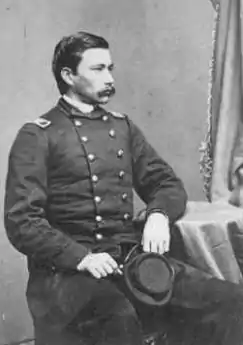George Dashiell Bayard
George Dashiell Bayard (December 18, 1835 – December 14, 1862) was a career soldier in the United States Army and a general in the Union Army in the American Civil War. He was wounded in the Battle of Fredericksburg and died the next day.
George Dashiell Bayard | |
|---|---|
 George Dashiell Bayard | |
| Born | December 18, 1835 Seneca Falls, New York |
| Died | December 14, 1862 (aged 26) Fredericksburg, Virginia |
| Place of burial | |
| Allegiance | United States of America Union |
| Service/ | United States Army Union Army |
| Years of service | 1856–1862 |
| Rank | |
| Commands held | 1st Pennsylvania Cavalry |
| Battles/wars | American Civil War |
Early life
He was born in Seneca Falls, New York on December 18, 1835 to Jane Ann Dashiell and Samuel John Bayard, the son of Samuel Bayard (1766–1840) and the grandson of John Bayard (1738–1807).[1][2]
His family moved as homesteaders to the Iowa Territory. He attended the United States Military Academy at West Point, graduating in 1856 as a second lieutenant in the U.S. cavalry. Bayard fought in the Indian Wars in Kansas and Colorado from 1856 to 1861. Bayard was shot in the face with a Kiowa arrow on July 11, 1860 and suffered considerable pain for months.[3]
Civil War
On August 27, 1861, Bayard was promoted to colonel in the 1st Pennsylvania Cavalry, based in Tenallytown (now Tenleytown, Washington, D.C.). Late in November 1861, he was involved in a confrontation with rebel soldiers near Dranesville, Virginia, in which his horse and two of his fellow soldiers were killed. He escaped with only minor wounds and was subsequently commissioned Chief of Cavalry of the III Corps and brigadier general of U.S. Volunteers on April 28, 1862.[3][4]
Bayard fought under John C. Frémont at the Battle of Port Republic. In August 1862, at the Battle of Cedar Mountain, he led a Union Army advance. He was eventually promoted to Chief of Cavalry of the Left Grand Division, Army of the Potomac. With his old wound still bothering him, Bayard took a leave of absence for 13 days in September and consequently missed the Battle of Antietam.[3][4]
Bayard was struck in the leg with a piece of shrapnel from a Confederate artillery round on December 13, 1862 at the Battle of Fredericksburg. He died the next day from uncontrolled bleeding, just four days short of his 27th birthday.[3] He was buried in Princeton Cemetery in Princeton, New Jersey.
Legacy
Fort Bayard in Washington D.C., was named in his honor. Bayard Street in Pacific Beach, San Diego, California and in his hometown, Seneca Falls, New York, were named after him. Fort Bayard Park, which replaced the fort, is also named in his memory, as well as Bayard, New Mexico, Fort Bayard, New Mexico, and Fort Bayard National Cemetery. The latter is now part of the Fort Bayard Historic District, a commemoration of the Buffalo Soldiers.
References
- Harrison, Richard A. (July 14, 2014). Princetonians, 1776-1783: A Biographical Dictionary. Princeton University Press. ISBN 9781400856534. Retrieved 16 March 2017.
- Bulloch, Joseph Gaston Baillie (1919). A History and Genealogy of the Families of Bayard, Houstoun of Georgia: And the Descent of the Bolton Family from Assheton, Byron and Hulton of Hulton Park, by Joseph Gaston Baillie Bulloch ... J. H. Dony, Printer. Retrieved 16 March 2017.
- "George Dashiell Bayard". Retrieved 2011-11-19.
- "Brig. Gen. George Bayard". Archived from the original on 2011-07-13. Retrieved 2011-11-19.